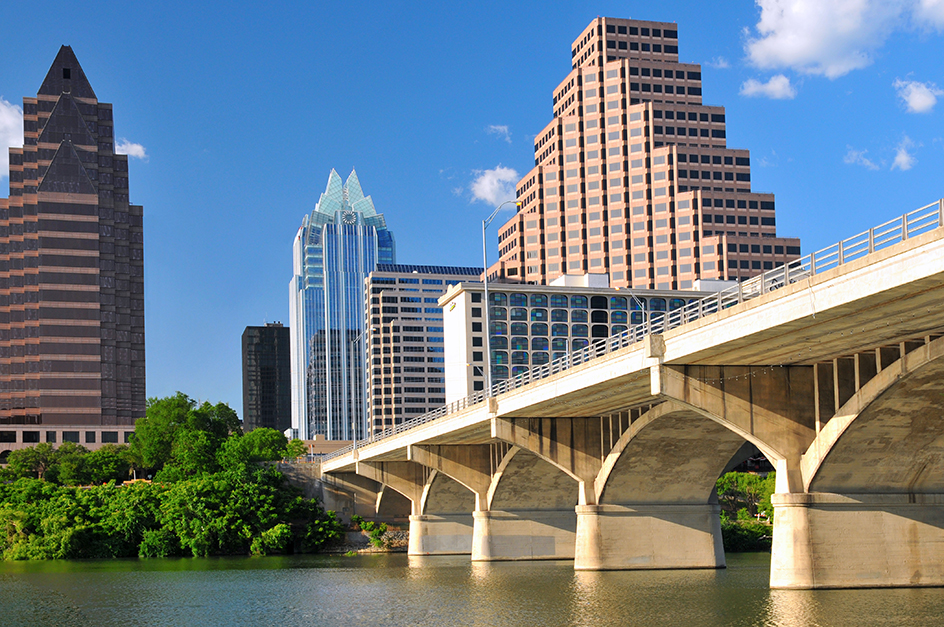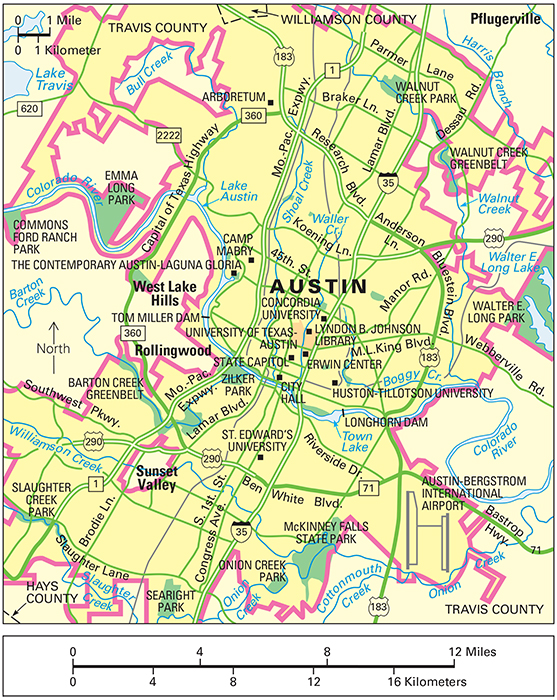Austin (pop. 961,855; met. area pop. 2,283,371) is the capital of Texas and the state’s educational center. The city of Austin lies on the Colorado River in south-central Texas.

In 1839, Austin was founded and became the capital of the Republic of Texas. Officials of the republic chose the site, on bluffs overlooking the Colorado River, for its beauty and central location. The city was named for pioneer Stephen F. Austin, often called the father of Texas.
Description.
Austin is the county seat of Travis County. The Austin-Round Rock-San Marcos metropolitan area consists of Bastrop, Caldwell, Hays, Travis, and Williamson counties.

The State Capitol, Austin’s chief landmark, is near the center of the city. State government agencies and institutions are throughout the city. The main campus of the University of Texas lies near the Capitol. Many athletic and entertainment events take place at the university’s Frank Erwin Center. Other institutions of higher learning include Austin Presbyterian Theological Seminary, Concordia University Texas, Lipscomb University Austin Center, Seminary of the Southwest, Huston-Tillotson University, and St. Edward’s University.
The Lyndon Baines Johnson Library and Museum on the University of Texas campus houses documents from the public career of the 36th president. The Texas Memorial Museum, also on campus, has exhibits on natural history. The Contemporary Austin exhibits works of art at its downtown site and at an estate called Laguna Gloria. Austin has a ballet association and symphony orchestra.
Economy.
The state, local, and federal governments employ a large percentage of Austin’s work force. The University of Texas, a state institution, ranks as the largest single employer.

Austin is the market center of a region that raises beef cattle and other farm products. Many trade organizations and associations have headquarters in Austin. The city is a center of the country music industry. Austin is famous for its parks, many of which are linked by greenbelts (belts of woodland or parkland).
The Austin metropolitan area has hundreds of manufacturing plants. The area is an important center for electronics and other high-technology industry. Many plants work with research institutions based in Austin. Other major industries include publishing and tourism.
Government.
Austin has a council-manager form of government. The voters elect a mayor and 10 other council members to three-year terms. The council hires a city manager to carry out its policies.
History.
When white settlers first arrived in the early 1800’s, Tonkawa Indians lived in what is now the Austin area. The settlers named their community Waterloo. In 1839, Waterloo was renamed Austin and incorporated as a city.
In 1900, when Austin had 22,258 people, the Colorado River flooded the lower part of the city and burst a dam. Since then, seven new dams have been built. They have created seven artificial lakes near Austin. These lakes provide recreation facilities.
In 1920, Austin had 34,876 people. Every 10 years from 1920 to 2000, Austin’s population increased by more than a third. During the 1970’s, the increases resulted mainly from the growth of the University of Texas and from Austin’s development as a center of business and government. During the 1970’s and early 1980’s, many large construction projects were undertaken in the Austin area. These included many office buildings, apartments, hotels, shopping centers, and university and state government buildings. In 1992, a new convention center opened in Austin. By 2020, Austin’s population had reached 961,855.
